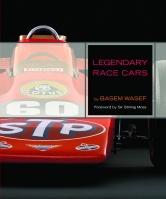 Legendary Race Cars, by Basem Wasef. Click image to enlarge |
By Russell Purcell
They say you can’t judge a book by its cover, but one look at Basem Wasef’s latest offering – Legendary Race Cars – will quickly change your mind about that statement. The book’s cover features a stunning studio shot of the 1968 Lotus Type 56 Turbine Indy car cloaked in the bold red of team sponsor STP. The off-centre photograph provides a menacing frontal view of this innovative machine that quickly captures your interest, and in a clever marketing move, the publishers have wrapped the book in a matching jacket-poster that they claim is suitable for framing. This is a clever idea that I wish more publishers would embrace as many automotive titles feature stunning cover art.
This is a follow up to the author’s first title, Legendary Motorcycles, with a similar concept dedicated to iconic racing machines. Assembling this dream list of four-wheeled eye candy was no small feat, but all Wasef’s hard work and research has resulted in a pretty unique book.
This is not just a book about 25 automobiles selected as personal favourites by an author trying to fulfill a publishing commitment. Instead, it is a close look at 25 very special (and varied) automobiles that proved themselves as exceptional examples of the automobile through success on the track. Each of the selected competition vehicles is featured in its own chapter. A nice mix of cars from all disciplines and eras, with everything from lumbering NASCAR stockers to lithe and nimble sports and formula cars is represented.
This book kicks off with a foreword penned by no less than Sir Stirling Moss, a legendary racing driver who is known to appreciate race cars for what they truly represent – “works of art.” I found myself anxious to turn the page after reading that the cars chosen to be featured in this book should be seen as individuals, and just like with a beautiful woman, “you have to know and respect her” to make this relationship work. One of Stirling’s own cars, a stunning Mercedes-Benz 300 SLR, is included in the final chapter.
After a series of debates and discussions with his friends and partners, the author managed to select a group of the world’s most historically significant race cars. While his list may differ from yours or mine, his wide cross-section is well-rounded and warranted.
The book reflects the author’s desire to support his selections, as it’s obvious that careful research was conducted to support the inclusion of each car, as well as to ensure accuracy in the details and specifications. This required Wasef to journey across Europe and the United States to get the job done.
The first chapter features Ford’s GT40, which is significant as it was designed as the Ford Motor Company’s weapon of choice to defeat Ferrari at Le Mans after the Italian company backed out of a planned industrial merger. Revenge was sweet, and the car is truly a legend.
The Mercedes-Benz W25 of 1934 helped the company ensure its success on the world stage of Grand Prix racing, but it also spawned the “Silver Arrows” moniker long associated with the German company’s racing cars after the team removed the car’s white paint to shed the one-kilogram of weight needed to meet the formula’s 750-kilogram weight limit. The author suggests this might be a legend, but it makes for a good story.
The Lotus 49 was the brainchild of engineering dynamo Colin Chapman. His inspired design married a lightweight chassis to a stress-bearing engine. This concept dominated open-wheel racing for decades.







 Follow Autos on Twitter
Follow Autos on Twitter



